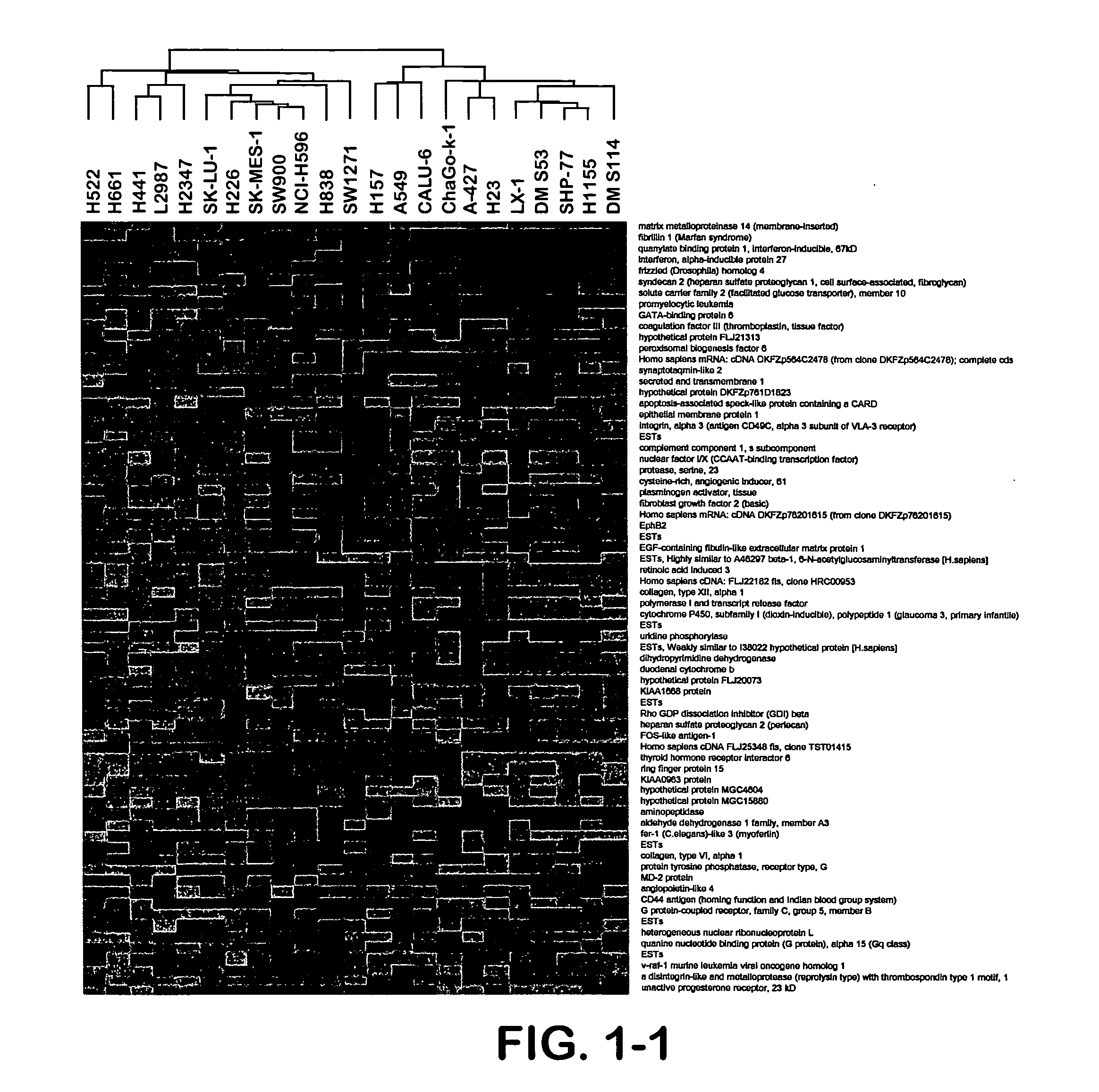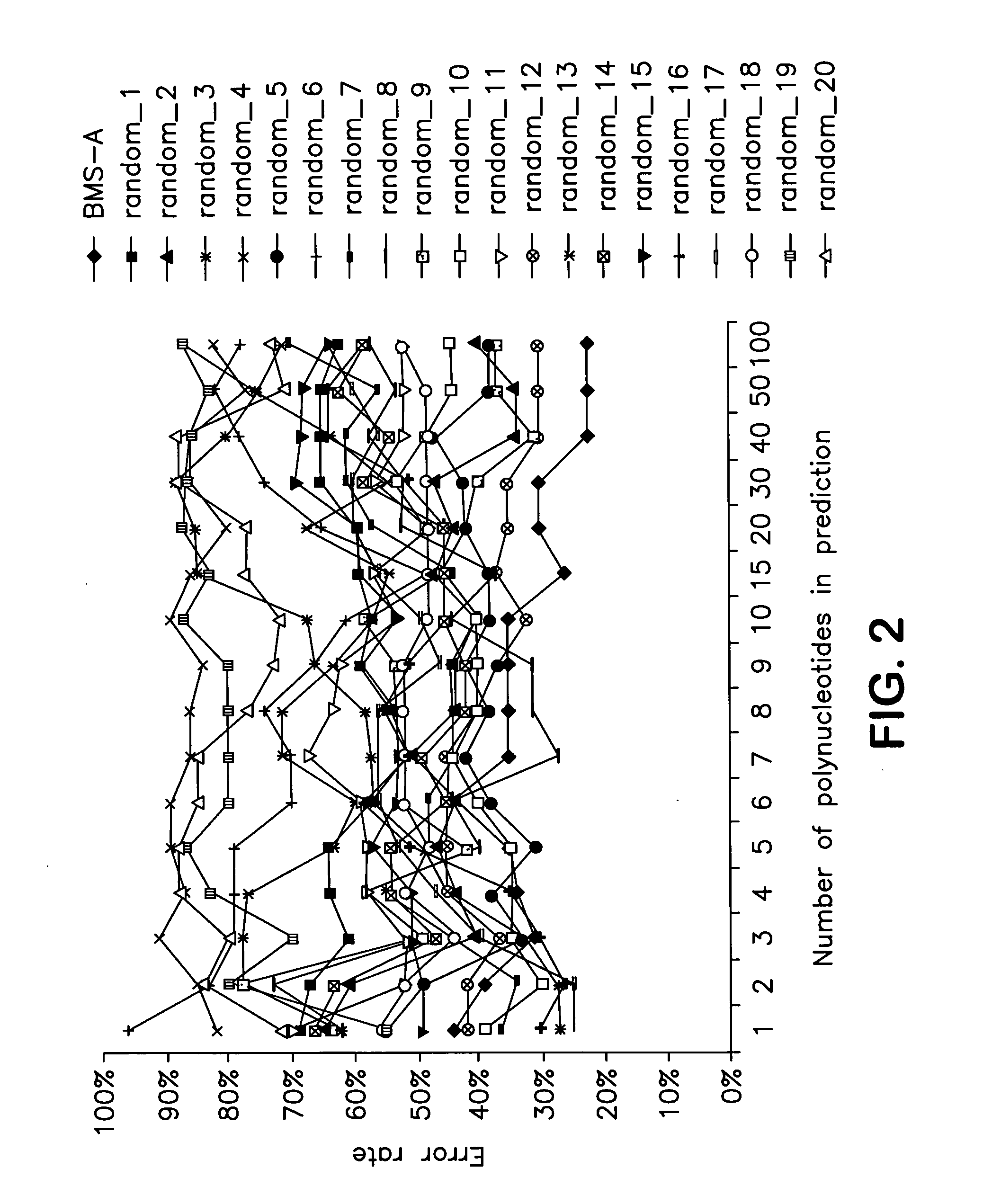Identification of polynucleotides for predicting activity of compounds that interact with and/or modulate protein tyrosine kinases and/or protein tyrosine kinase pathways in lung cancer cells
a technology of protein tyrosine kinase and polynucleotide, applied in the field of identification of polynucleotides for predicting the activity of compounds that interact with and/or modulate protein tyrosine kinases and/or protein tyrosine kinase pathways in lung cancer cells, can solve the problem of particularly challenging inability to predict drug sensitivity in patients
- Summary
- Abstract
- Description
- Claims
- Application Information
AI Technical Summary
Benefits of technology
Problems solved by technology
Method used
Image
Examples
example 1
Methods
IC50 Determination—In Vitro Cytotoxicity Assay
[0243] The protein tyrosine kinase inhibitor compound (described in international application WO 00 / 62778, published Oct. 26, 2000) was tested for cytotoxicity in vitro against a panel of twenty-three human lung cell lines available from the American Type Culture Collection, ATCC. Cytotoxicity was assessed in cells by the MTS (3-(4,5-dimethylthiazol-2-yl)-5-(3-carboxy-methoxyphenyl)-2-(4-sulphenyl)-2H-tetrazolium, inner salt) assay (T. L. Riss et al., 1992, Mol. Biol. Cell, 3 (Suppl.): 184a).
[0244] To carry out the assays, the lung cells were plated at 4,000 cells / well in 96 well microtiter plates, and 24 hours later, serially diluted drugs were added. The concentration range for the protein tyrosine kinase inhibitor compound BMS-A used in the cytotoxicity assay was from 5 μg / ml to 0.0016 μg / ml (roughly 10 μM to 0.0032 μM).
[0245] The cells were incubated at 37° C. for 72 hours at which time the tetrazolium dye, MTS (333 μg / ml...
example 2
PCR Expression Profiling
[0258] RNA quantification is performed using the Taqman® real-time-PCR fluorogenic assay. The Taqman® assay is one of the most precise methods for assaying the concentration of nucleic acid templates.
[0259] RNA is prepared using standard methods, preferably, employing the RNeasy Maxi Kit commercially available from Qiagen (Valencia, Calif.). A cDNA template for real-time PCR can be generated using the Superscript™ First Strand Synthesis system for RT-PCR. Representative forward and reverse RT-PCT primers for each of the protein tyrosine kinase biomarker polynucleotides of the present invention are provided in Table 6.
[0260] SYBR Green real-time PCR reactions are prepared as follows: The reaction mix contains 20 ng first strand cDNA; 50 nM Forward Primer; 50 nM Reverse Primer; 0.75×SYBR Green I (Sigma); 1×SYBR Green PCR Buffer (50 mM Tris-HCl pH 8.3, 75 mM KCl); 10% DMSO; 3 mM MgCl2; 300 μM each dATP, dGTP, dTTP, dCTP; 1 U Platinum® Taq DNA Polymerase High ...
example 3
Production of an Antibody Directed Against Protein Tyrosine Kinase Biomarker Polypeptides
[0264] Anti-protein tyrosine kinase biomarker polypeptide antibodies of the present invention can be prepared by a variety of methods as detailed hereinabove. As one example of an antibody-production method, cells expressing a polypeptide of the present invention are administered to an animal as immunogen to induce the production of sera containing polyclonal antibodies directed against the expressed polypeptide. In a preferred method, the expressed polypeptide is prepared, preferably isolated and / or purified, to render it substantially free of natural contaminants using techniques commonly practiced in the art. Such a preparation is then introduced into an animal in order to produce polyclonal antisera of greater specific activity for the expressed and isolated polypeptide.
[0265] In a most preferred method, the antibodies of the present invention are monoclonal antibodies (or protein binding ...
PUM
| Property | Measurement | Unit |
|---|---|---|
| pH | aaaaa | aaaaa |
| pH | aaaaa | aaaaa |
| pH | aaaaa | aaaaa |
Abstract
Description
Claims
Application Information
 Login to View More
Login to View More - R&D
- Intellectual Property
- Life Sciences
- Materials
- Tech Scout
- Unparalleled Data Quality
- Higher Quality Content
- 60% Fewer Hallucinations
Browse by: Latest US Patents, China's latest patents, Technical Efficacy Thesaurus, Application Domain, Technology Topic, Popular Technical Reports.
© 2025 PatSnap. All rights reserved.Legal|Privacy policy|Modern Slavery Act Transparency Statement|Sitemap|About US| Contact US: help@patsnap.com



